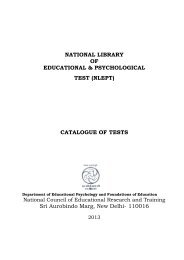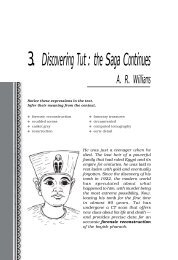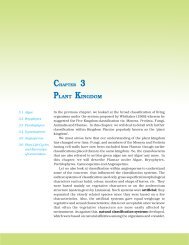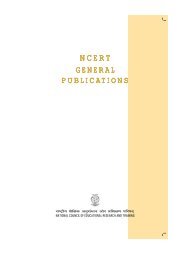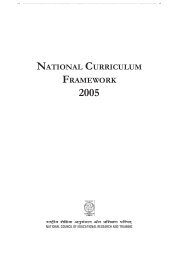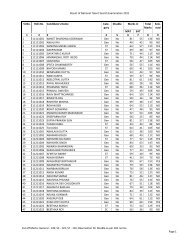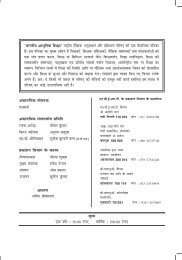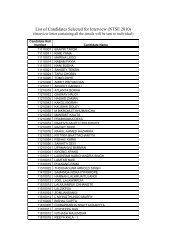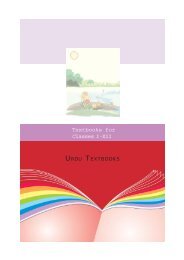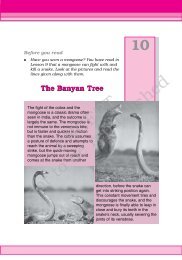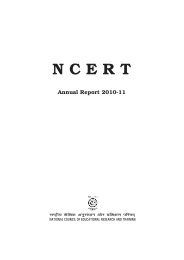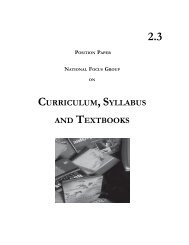indian education - National Council Of Educational Research And ...
indian education - National Council Of Educational Research And ...
indian education - National Council Of Educational Research And ...
You also want an ePaper? Increase the reach of your titles
YUMPU automatically turns print PDFs into web optimized ePapers that Google loves.
42 Journal of Indian Education August 2007<br />
grounds. A Mother’s Committee takes<br />
charge of mid-day meals, hosts metric<br />
melas and overseas the teacher’s work.<br />
A Rural Health Centre has been<br />
providing quality primary health care to<br />
the villages in the area. The success in<br />
the immediate vicinity has drawn people<br />
from as far as one hundred fifty kilo<br />
meters away. A unique feature of the<br />
centre is nurses trained in each village<br />
to monitor that patients continue<br />
treatment. A volunteer from each of<br />
these villages receives training from the<br />
Health Centre on AIDS awareness.<br />
These multi-grade, multi-level<br />
teaching and learning methodology has<br />
become a model for thousands of formal<br />
and non-formal schools in several parts<br />
of the country. Among the more<br />
prominent adaptations of the<br />
methodology are the famous Nali Kali<br />
experiment in the formal schools of HD<br />
Kote block of Mysore Districts and the<br />
Corporation Schools in Chennai. We<br />
have just signed an agreement with a<br />
UNICEF and Sarva Siksha Abhayan<br />
(SSA) supported programme for defining,<br />
designing and developing ‘a holistic<br />
quality package of essential<br />
interventions for primary schools,’ in<br />
several states, including Gujarat,<br />
<strong>And</strong>aman and Nicobar Islands. Orissa,<br />
Bihar and Jharkhand.<br />
Conservation Work<br />
The <strong>education</strong>al work of Rishi Valley is<br />
nested in actual practice — water<br />
conservation, soil and moisture<br />
conservation, reforestation, preserving<br />
local species of domesticated cattle, use<br />
of alternative energy are all part of our<br />
work that benefits the inhabitants of the<br />
valley and introduces students to an<br />
alternative lifestyle.<br />
Water is the Valley’s greatest<br />
problem. Monsoons are erratic and the<br />
few natural streams flow only during the<br />
monsoon season and swiftly grow dry. For<br />
most of the year underground water<br />
drawn from wells is the only source of<br />
water. The ground water stood at one<br />
hundred-thirty meters below ground<br />
level, as a result of too many new wells<br />
being dug by the school’s need to bathe<br />
and feed five-hundred inhabitants,<br />
maintain its dairy and by farmers who<br />
now grow paddy instead of the rain-fed<br />
millet and peanuts.<br />
Serious water harvesting began in<br />
the seventies with the Centre donating<br />
its own land for the construction of two<br />
percolation tanks, and supervising<br />
projects financed by the <strong>And</strong>hra Pradesh<br />
government. The two tanks, the first<br />
called ‘Lost Lake,’ situated midway up the<br />
hills to the south of the campus helped<br />
regenerate one hundred-fifty acres of a<br />
once-barren hillside. The other, situated<br />
in the valley, services wells three miles<br />
downstream and has resulted in a much<br />
more prosperous farming community.<br />
Five more tanks were built more recently<br />
in the Valley.<br />
Beginning in 1988, under a grant<br />
from the Wasteland Development Board,<br />
the Centre built small check dams and<br />
bunds along the contours of an 800hectares<br />
hillside. This meant persuading<br />
villagers to donate labour and allow<br />
construction of bunds across their small<br />
holdings. Custard Apples, which goats<br />
avoid, were planted along the bunds to<br />
hold in soil. Large nurseries of jamun,<br />
tamarind, peepal, red sander and neem<br />
saplings were established. Several of<br />
these were given away to farmers from



